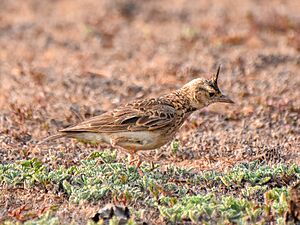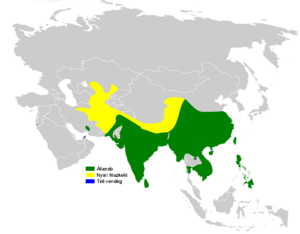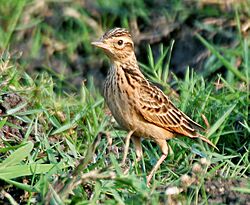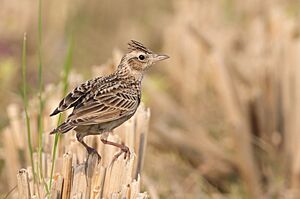Oriental skylark facts for kids
Quick facts for kids Oriental skylark |
|
|---|---|
 |
|
| In India | |
| Conservation status | |
| Scientific classification | |
| Genus: |
Alauda
|
| Species: |
gulgula
|
| Subspecies | |
|
See text |
|
 |
|

The Oriental skylark (Alauda gulgula), also known as the small skylark, is a type of skylark bird. You can find it in open grassland areas across Asia, from India to parts of China. Like other skylarks, it loves to eat seeds and insects.
Contents
About the Oriental Skylark
What's in a Name? (Taxonomy)
The Oriental skylark was first described by a British soldier and naturalist named James Franklin in 1831. He gave it the scientific name Alauda gulgula. The meaning of gulgula is not fully clear. It might refer to the bird's song, as gula means "throat" in Latin. It could also be linked to a sweet treat called "gulgula" that looks like a doughnut.
This bird has other names too, like the eastern skylark, Indian skylark, and lesser skylark.
Different Types (Subspecies)
There are thirteen different types, or subspecies, of the Oriental skylark. These are slightly different versions of the same bird, often found in different places:
- Kashmir skylark (A. g. lhamarum) - Meinertzhagen, R & Meinertzhagen, A, 1926: Lives in the Pamir Mountains and western Himalayas.
- A. g. inopinata - Bianchi, 1905: Found on the Tibetan Plateau and in north-western China.
- A. g. vernayi - Mayr, 1941: Lives in the eastern Himalayas and south-western China.
- Western Oriental skylark (A. g. inconspicua) - Severtsov, 1873: Found from southern Kazakhstan to eastern Iran, Pakistan, and north-western India.
- A. g. gulgula - Franklin, 1831: Lives from north-central India to Sri Lanka and east to northern Indochina.
- A. g. dharmakumarsinhjii - Abdulali, 1976: Found in west-central India.
- A. g. australis - Brooks, WE, 1873: Lives in south-western India.
- A. g. weigoldi - Hartert, 1922: Found in central and eastern China.
- A. g. coelivox - R. Swinhoe, 1859: Lives in southern and south-eastern China, and northern Vietnam.
- A. g. sala - R. Swinhoe, 1870: Found on Hainan Island (off south-eastern China).
- A. g. herberti - Hartert, 1923: Lives from central and eastern Thailand to southern Vietnam.
- A. g. wattersi - R. Swinhoe, 1871: Found in Taiwan.
- A. g. wolfei - Hachisuka, 1930: Lives on Luzon (northern Philippines).
What Does it Look Like? (Description)
Oriental skylarks are about 16 centimeters (6.3 inches) long. They have streaky, yellow-brown plumage (feathers) on their upper bodies. Their outer tail feathers are white, and they have a short crest (a tuft of feathers) on their heads. Both male and female birds look very similar.
This skylark is a bit different from the Eurasian skylark. It is smaller and has a longer, pointier beak. Its outer tail feathers are more buff-colored, and it doesn't have the white edge on its wings when it flies.
Where Do They Live? (Habitat)
These larks breed across the Sino-Indian region and parts of central Asia. During winter, they fly to the warmer southern parts of their range.
You usually find them in open areas with short plants. This includes grasslands, marshes, and the edges of lakes. They eat seeds and insects. They tend to avoid forests, but you might see them in large clearings within a forest.
How Do They Behave? (Ecology)
Oriental skylarks often fly straight up into the sky. They flutter their wings and sing before coming back down to the ground. Male skylarks also hover in the air and sing to attract a mate.



